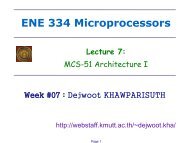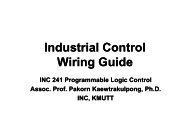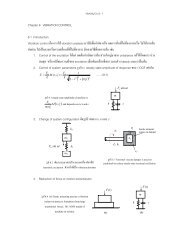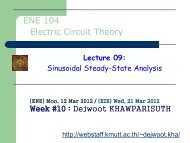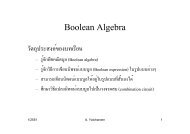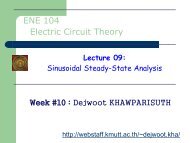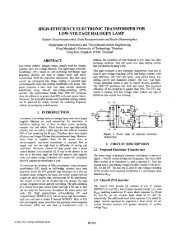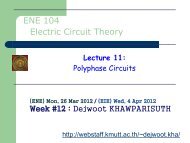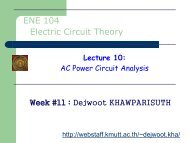Model-based fault-detection and diagnosis ... - web page for staff
Model-based fault-detection and diagnosis ... - web page for staff
Model-based fault-detection and diagnosis ... - web page for staff
Create successful ePaper yourself
Turn your PDF publications into a flip-book with our unique Google optimized e-Paper software.
Table 1<br />
Fault-<strong>detection</strong> of a non-linear static process via parameter estimation <strong>for</strong><br />
steady states<br />
2.2. Fault-<strong>detection</strong> with parameter estimation<br />
Process model-<strong>based</strong> methods require the knowledge of a<br />
usually dynamic process model in <strong>for</strong>m of a mathematical<br />
structure <strong>and</strong> parameters. For linear processes in continuous<br />
time the models can be impulse responses (weighting<br />
functions), differential equations of frequency responses.<br />
Corresponding models <strong>for</strong> discrete-time (after sampling) are<br />
impulse responses, difference equations or z-transfer<br />
functions. For <strong>fault</strong>-<strong>detection</strong> in general differential equa-<br />
Table 2<br />
Linear dynamic process models <strong>and</strong> <strong>fault</strong> modeling<br />
R. Isermann / Annual Reviews in Control 29 (2005) 71–85 73<br />
tions or difference equations are primarily suitable. In most<br />
practical cases the process parameters are partially not<br />
known or not known at all. Then, they can be determined<br />
with parameter estimation methods by measuring input <strong>and</strong><br />
output signals if the basic model structure is known. Table 3<br />
shows two approaches by minimization of the equation error<br />
<strong>and</strong> the output error. The first one is linear in the parameters<br />
<strong>and</strong> allows there<strong>for</strong>e direct estimation of the parameters<br />
(least squares estimates) in non-recursive or recursive <strong>for</strong>m.<br />
The second one needs numerical optimization methods <strong>and</strong><br />
there<strong>for</strong>e iterative procedures, but may be more precise<br />
under the influence of process disturbances. The symptoms<br />
are deviations of the process parameters DQ. As the process<br />
parameters Q ¼ f ðpÞ depend on physically defined process<br />
coefficients p (like stiffness, damping coefficients, resistance),<br />
determination of changes Dp allows usually a deeper<br />
insight <strong>and</strong> makes <strong>fault</strong> <strong>diagnosis</strong> easier (Isermann, 1992).<br />
Parameter estimation methods operate with adaptive process<br />
models, where only the model structure is known. They<br />
usually need a dynamic process input excitation <strong>and</strong> are<br />
especially suitable <strong>for</strong> the <strong>detection</strong> of multiplicative <strong>fault</strong>s.<br />
2.3. Fault-<strong>detection</strong> with observers<br />
If the process parameters are known, either state<br />
observers or output observers can be applied, Table 4. Fault<br />
modeling is then per<strong>for</strong>med with additive <strong>fault</strong>s fL at the




